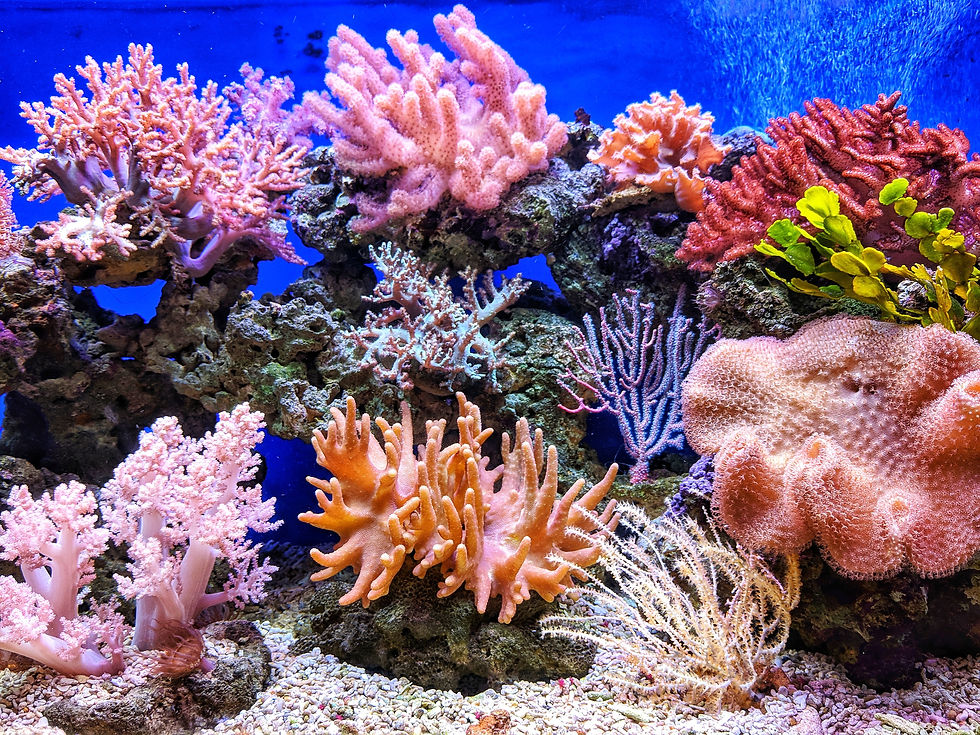Recycling Plastic Won’t Solve Ocean Pollution
- Marzia Marini

- Jun 8, 2021
- 4 min read
Updated: Aug 16, 2021
Oceans are an essential global resource. They regulate the climate, produce over half of the world’s oxygen and give us food. Their role in the global economy is massive: over three billion people depend on marine and coastal biodiversity for their livelihoods.
However, human activities are alarmingly harming global oceans’ health and, as the second most polluting industry, fashion is doing its part. In fact, the apparel industry is responsible for 20% of global wastewater, with laundry alone releasing annually half a million tonnes of plastic into the ocean.
To solve oceans pollution, many brands are looking at recycling. Plastic bottles and fishing nets are being turned into polyester and nylon fibres to produce sneakers, swimwear, jackets, leggings, and sports bras. At this moment in time, it doesn’t matter the item you are looking for – I guarantee you can find a “made with marine plastic” version of it.
But is it really working? Or is it just a new strategy to sell more clothes?
Recycling is like reaching for the mop to soak when the sink is overflowing
The idea of turning plastic waste into fabrics is not new. The brand Patagonia, for example, has been using plastic bottles to produce its garments since 1993, when it invented Fleece, a cosy, soft fabric primarily used in jackets and sweaters. The number of companies that joined the cause in the meantime is huge. adidas, Girlfriend Collective, Burberry, Norton Point, Stella McCartney, Nike and H&M are just a few.
However, despite the high number of participants, recycling initiatives haven’t even scratched the ocean waste issue. At the moment, there are 5.25 trillion pieces of plastic debris in the oceans. And without drastic interventions, the amount of plastic in the oceans will overcome the one of fish by 2050.
The reason behind recycling’s ineffectiveness is simple: it doesn’t tackle the origin of the problem.
There is a popular analogy used to talk about plastic pollution: if your bathroom sink is overflowing, you don’t reach for the mop to soak up the overflow; you turn off the tap. That’s the same with plastic recycling. What’s the point of collecting waste from the oceans when we continue to throw in 8 millions of tonnes of plastic every year?
“If beach plastic recycling programs or any well-meaning ocean plastic company was a 100% successful, it would still be too little, too late”. David Katz, founder of Plastic Bank
Ocean plastics throw off just as much microplastics as other synthetic materials
Producing objects with recycled ocean plastic is undoubtedly better than using virgin plastic. It requires fewer oils and resources, and even if imperceptibly, it reduces the amount of waste on our planet.
But in the end, recycling plastic means producing other plastic products. Plastic products that have all the attributes and environmental issues of conventional plastic.
Take clothes. The washing of synthetic garments is the cause of a third of the microplastics in our oceans. And in the washing machine, there is no difference between synthetic fabrics made with virgin or recycled plastic. The quantity of plastic released is the same.
Microplastics are one of the most dangerous types of debris. Recent studies found out a link between these microparticles and human diseases as obesity, infertility, and cancer. Due to their dimensions – one fifth the size of a human hair – they are everywhere, in our food, water and air. It is impossible to avoid them and it is even more difficult to get rid off of them.
Upcycled clothes still require chemicals
Along with throwing off microplastics, the release of toxic chemicals is the other fashion industry’s big contribution to ocean pollution.
Chemicals are a vital component during the manufacturing process of clothes. They are used to dye, bleach, and wet each of our garments. Many of these chemicals are very toxic to the human body. For this reason, governments worldwide have regulations to discharge them safely.
But in developing countries, like Bangladesh and India, where most of our clothes are produced, factories too often find a way to twist laws and dump wastewater directly into rivers and streams, contaminating the environment and drinking water sources.
Recycled fabrics are not excluded from these processes. Actually, maritime waste that is too damaged to be recycled usually ends up being burned and converted into fuel. This process is part of the so-called chemical recycling, which has recently been discussed in details by The Huffington Post.
Upcycled clothes feed overconsumption
Not only is using recycled plastic in fashion not a solution, not only it is a distraction from tackling the real problems, but it feeds overconsumption, the first cause behind the mountains of waste in our oceans.
Many consumers think that founding companies that are collecting waste from oceans, their purchases have a positive outcome. They buy upcycled clothes with the false idea of contributing to the reduction of global waste, while retailers capitalise on these emotions, pushing more and more people to buy more and more recycled products. And this is just the same old over polluting consumerism.
As long as we don’t learn to produce less waste, there is no way to stop the disruption of our marine ecosystems.
In the future, we will obviously have to deal with the huge amount of waste we created and maybe recycling will be the solution. But first, we have to stop creating trash. And we have to do it now!
If interested in ending ocean pollution and contributing to the demolition of the western throw-away culture, Mindless Mag dedicated the month of March to this topic and offered exit routes for those who found themselves trapped inside.



Comments